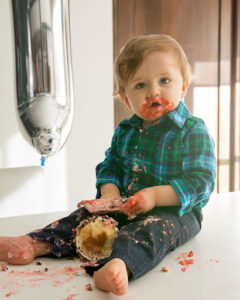
As most of us know, our children can get very messy when they eat! Did you know this is actually the best way for them to learn about and try new foods?
Picture yourself at a new restaurant. You order something off the menu that someone else recommended but when it comes to the table it is different from anything you’ve ever eaten before. What do you do? Do you dive right in and take a huge bite? Probably not. You likely interact with the food first. Maybe you simply look at the food, observe all the different colors on the plate. You may even cut the food open and/or push it around the plate to observe its different properties (e.g., squishy, dry, wet, crunchy, etc.). Next, you may smell the food. Is it a good smell or is it making you want to push the plate away? Finally, you may take a little bite off to taste it before eating an entire fork/spoon full.

